Covering the Heart of the Farmington Valley



A white-throated sparrow perches in an ilex bush in a Canton yard this past April — ilex is another name for holly — white-throated sparrows can be found across the northeastern United States, the northern Midwest and Canada

by
4 — Parkinson Enigma
As researchers continue to seek an answer to the puzzle of Parkinson’s disease, the APDA honors a local Parkinson’s hero
12 — Family Matters
A daughter recalls her Dad’s PD journey — and how her parents valiantly battled Parkinson’s together
14 — Expert Insight
Doctors from area hospitals weigh in on how close we are to a PD cure and other key questions
18 — Daughter-Dad Bond
Another daughter honors her Dad’s resilience and family focus as he dealt with Parkinson’s
“With proper diagnosis and management, patients with PD can live long, productive, happy lives ” — Dr. Bernardo Rodrigues • UConn Health 1.2M — U.S. Parkinson’s cases
COVER STORY KUDOS
RESEARCHING info and statistics about Parkinson’s disease for this month’s cover story revealed an abundance of new knowledge for me — and confirmed that finding universal agreement can be elusive.
For example — reputable sources differ regarding the ratio of male and female PD cases. Men are 1.5 times more likely to have the disease, according to the Parkinson’s Foundation and a prominent neurology journal, but the National Institutes of Health and ScienceDaily.com say the risk of developing PD is twice as high in men.
When sources offer divergent facts and discordant truth claims, how is it possible to confirm accuracy and veracity? Presumably, the best source to trust is the one with accurate and truthful info. Yet the question of determining the reliability of a source has evidently been debatable since the dawn of human history. Another disagreement centers on a cure for Parkinson’s — read our coverage to see what local experts say … BWD

Our April cover story marks the 25th anniversary of the first national title for UConn men’s basketball — CLICK HERE for our coverage WHAT A GREAT idea for a magazine cover story! Well planned. Had the UConn women been able to win again this year — highly improbable given all the injuries (amazing what they did accomplish) — it would have been a 10-10-10 situation: two national champions in 2004, two national champions in 2014 and two in 2024. — Nancy Lehman • Simsbury
THE AVON Historical Society thanks the exhibitors, attendees and many volunteers who made Tablescapes 2024 a great success! Special thanks to the Chabot family, owners of The North House, for their commitment to allow us to have this annual event in their Belle Ballroom.
This year’s exhibitors brought their talent and expertise in flower arranging, table setting and design enjoyed by over 300 attendees. Proceeds go directly to the exhibit curation in the new Avon History Museum.
The Avon Historical Society invites anyone interested in being an exhibitor or sponsor of Tablescapes 2025 to contact us at info@avonhistoricalsociety.org
—Terri Wilson • President • Avon Historical Society
THANK YOU so much for continuing to list our free antique appraisals every Saturday in the Today Calendar and for the great articles and information your publication provides.
—Jean McCarthy • ANTIQ’S • Farmington
Excellent issue! —David Richman • Richman Business Brokerage & Insurance
LETTERS POLICY — Letters to the editor are welcome — ideal maximum length: 100 words — provide your full name, hometown, email address and phone number
Today Magazine • Covering the Heart of the Farmington Valley
Bruce William Deckert — Publisher + Editor-in-Chief 860-988-1910 — Bruce.Deckert@TodayPublishing.net www.TodayPublishing.net — Award-Winning Today Online — www.TodayPublishing.net/blog
Follow Today Magazine CT on social media >
Advertising — Contact the Publisher
Editorial Associate — Kayla Tyson
Contributing Photographer — Wendy Rosenberg Five Towns • One Aim — Exceptional Community Journalism Community News That Matters Nationwide
Associate Broker Five Star Professional Award-Winning Real Estate Agent
860-965-3652 • CELL 860-676-1200 • OFFICE
odalys.bekanich@cbmoves.com
290 West Main Street Avon, CT 06001
Operated by a subsidiary of NRT LLC



The Erardi family — Lauren, Mary Lou, Rocco aka “Roc” and Scott — traveled in 2018 to Sedona, Arizona — about 115 miles north of Phoenix ON THE COVER
The Erardi family — also in 2018
“ If we can encourage more people with Parkinson’s disease clinical trials, then the world can keep moving closer toward the participants in the study of the compound that proves Because of me, the whole world can now say WE have
— Dr. Joy Antonelle de Marcaida • Hartford HealthCare

disease to volunteer to participate in toward finding the cure … Someday, proves to be the cure will be able to say : have ended Parkinson’s disease ” HealthCare medical director
CHANCES ARE you know someone who has Parkinson’s disease — a family member or friend, a colleague or acquaintance. Parkinson’s is one of the most common neurological diseases worldwide, according to the National Institutes of Health aka NIH. Neurology is the branch of medicine concerned with the nervous system.
An estimated 12,000 Connecticut residents have been diagnosed with Parkinson’s, according to the state chapter of the American Parkinson Disease Association aka APDA.
Connecticut’s population is about 3.6 million, per the 2020 census, so less than 1% of state citizens are afflicted with Parkinson’s — 0.3% to be more precise.
The APDA estimates that 10 million people worldwide and 1.2 million people nationwide have Parkinson’s — also about 0.3% of the U.S. population of 331 million. A caveat regarding the national numbers: About 1 million Americans have the disease per the APDA website, but a state APDA representative tells Today Magazine that the nationwide estimate has changed to 1.2 million cases.
By the way, April is Parkinson’s Disease Awareness Month.
Despite the small percentages, for many individuals and families a Parkinson’s diagnosis looms large due to the significance of a condition that worsens over time — further, there is no known cure.
The APDA’s Connecticut chapter is honoring longtime Avon resident Rocco “Roc” Erardi in memoriam at
the Northern CT Optimism Walk on the first Saturday in May at the Farmington Polo Club. The Optimism Walk is a family-friendly fundraising event supporting APDA services and programs.
After battling Parkinson’s for 16-plus years, Erardi died in July 2022 at 75 years of age. He was born in Hartford and grew up mainly in Manchester after his family moved from East Hartford. He graduated from Manchester High School in 1965.

Erardi served as vice president of the Avon Soccer Club and coached club teams for nearly two decades before becoming an assistant coach for Connecticut’s Olympic Development Program. The Connecticut Junior Soccer Association honored him with the organization’s Sportsmanship Award.
A UConn graduate with a bachelor’s degree in English, Erardi was a sporting-goods buyer for G. Fox & Co. and later became a licensed property and casualty agent with The Hartford insurance company.
He retired from The Hartford in 2006, the same year he was diagnosed with Parkinson’s — for more about his life and legacy, see the sidebar article by his daughter Lauren Erardi.
The disease is named after James Parkinson, who identified and described a shaking palsy condition in 1817, according to the NIH. The term Parkinson’s disease was coined by William Rutherford Sanders of Edinburgh in 1865 and later became
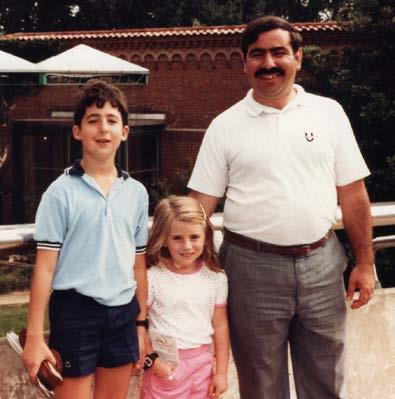

a commonplace description through the influence of Jean-Martin Charcot and his school that was based at a Paris hospital.
While Parkinson’s disease can be managed effectively, it is a far more life-altering diagnosis practically and psychologically than, say, a diagnosis of an essential tremor. A hand tremor is a common symptom of both conditions, but the Parkinson’s package includes a number of other unwelcome manifestations.
Except for Alzheimer’s disease, Parkinson’s is the most common neurodegenerative condition affecting Americans, according to Dr. Bernardo Rodrigues, division chief for the Parkinson’s Disease and Movement Disorders Program at Farmingtonbased UConn Health.
“Parkinson’s disease is a progressive disease that can lead to disability and can affect activities of daily living, which makes it a shocking diagnosis,” Rodrigues says.
“PD affects primarily the motor function — tremors, stiffness, slowed movements and balance changes —



Above — Rocco Erardi coached the Avon Chargers to the U10 State Cup championship in 1988 — his daughter Lauren (#6) was a defender, usually at sweeper — he led Lauren’s Avon Soccer Club teams for 12 years — next to Erardi is assistant coach Gary Corliss , who died in 2015 at 72 years old
Right — Lauren and her dad display their gold medals after he coached the West Region U13 Girls to victory at the Nutmeg State Games in 1991 — Lauren later played varsity soccer at Avon High — she served as captain her senior year
so most of the adjustments revolve around optimizing physical condition and safety.”
The NIH defines Parkinson’s as a chronic and progressive neurological disease marked by muscle tremors, rigidity, slowness of movement, impaired balance and a shuffling gait. Further, many PD patients experience behavioral changes and cognitive impairment.
Since people worldwide are living longer, “PD represents a significant and increasing threat to public health,” per the NIH, and the annual cost of treatment in the United States has been estimated at $14.4 billion.
Parkinson’s impacts the part of the brain that produces dopamine, a neurochemical connected with controlling movement, says Dr. Joy Antonelle de Marcaida of Hartford HealthCare.
“The pathology of Parkinson’s disease is complex, and we now know that this can predate the diagnosis of PD by decades,” says De Marcaida, medical director for the
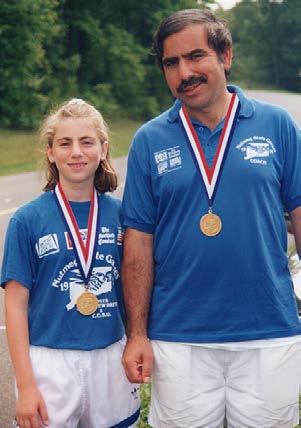
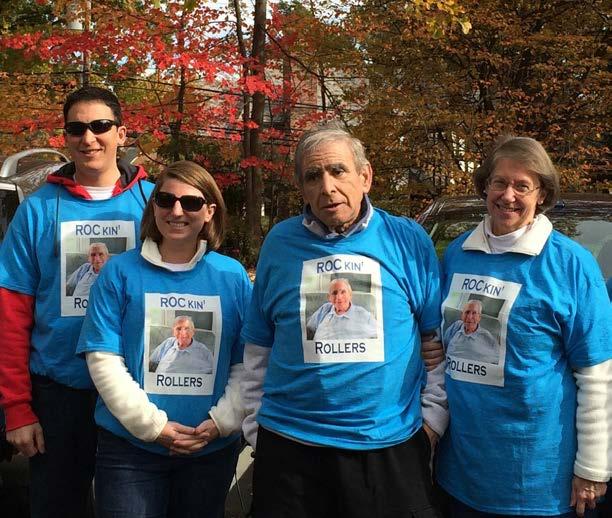
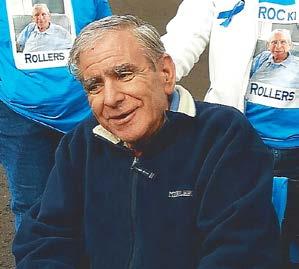
David & Rhoda Chase Family Movement Disorders Center. “Loss of brain cells ... results in a dopamine deficiency and manifests with these cardinal motor symptoms: slowness of movement, rest tremor, rigidity of the muscles and balance impairment,”
Naturally, treatment for Parkinson’s focuses on this vital neurochemical, notes Dr. Nirav Sanghani of Saint Francis Hospital.
“Most of the current treatments are directed toward supplementing dopamine, or enhancing the effect of whatever dopamine is present in the brain,” says Sanghani, a staff physician in the Department of Neurology.
“The acceptance of a newly diagnosed Parkinson’s disease and its effect on quality of life depend upon the severity of symptoms,” he says, adding that “many people find no significant change in quality of life, especially with the recent advances in physical therapy combined with medications.”
Scott, Lauren, Rocco and Mary Lou Erardi formed the ROCkin’ Rollers team in 2015 for the Optimism Walk hosted by the state chapter of the American Parkinson Disease Association — Roc is being honored in memoriam at this year’s walk at the Farmington Polo ClubThese advances provide a measure of hope for those diagnosed with the condition.
Current research indicates that Parkinson’s patients can take action to change the trajectory of the disorder, says De Marcaida. She highlights that simple wellness habits — such as exercising, eating healthy, sleeping well and maintaining social connections — can restrain the progression of Parkinson’s.
“This means that, in many ways, the power over Parkinson’s disease is in your hands,” she says, adding that “research in the field is robust.”
She further notes that over 30 medications and procedural options can effectively treat symptoms.
“The current treatments available ... offer remarkable improvement of symptoms,” says Rodrigues, “and can allow patients to continue to be fully independent for years. ... With proper care, dedication to regular physical activity, exercising and fall prevention, patients can live a long, happy and healthy life.”
He underscores that “this is a very serious condition, but slowly progressive and with extremely effective symptomatic treatments, which includes medications and surgical interventions.”

“ The current treatments available ... offer remarkable improvement of symptoms and can allow patients to continue to be fully independent for years ”— Dr. Bernardo Rodrigues UConn Health division chief
Famous figures who have received a Parkinson’s diagnosis include Alan Alda, Muhammad Ali, Neil Diamond, Billy Graham, Jesse Jackson, Pope John Paul II and Linda Ronstadt.
Perhaps the most recognizable Hollywood celebrity with Parkinson’s is Michael J. Fox, who has lived with the condition for more than three decades. He was diagnosed with young-onset Parkinson’s disease in 1991 when he was only 29 years old. In 2000 he established
The Michael J. Fox Foundation for Parkinson’s Research, the world’s largest nonprofit funder for Parkinson’s drug development, according to the foundation’s website — raising over $1.75 billion to date.
goal: “The Michael J. Fox Foundation is dedicated to finding a cure for Parkinson’s disease through an aggressively funded research agenda,” per the website. “Recent Parkinson’s progress has propelled us into a new age of research where a cure is within reach.”
However, this optimistic and hopeful outlook disagrees with the NIH perspective on the remedy question: “Parkinson’s disease is a complex neurodegenerative disorder with no cure in sight” — so says the NIH’s National Library of Medicine website.
What about local medical experts here in Greater Hartford — what is their take on a cure for Parkinson’s?
“Finding a cure has proven to be quite challenging,” says Hartford HealthCare’s De Marcaida. “However, each year of research brings us a deeper understanding of its pathophysiology, and closer and closer to finding a cure.”
Saint Francis’ Sanghani points to the neurochemical component.
1/4 PAGE AD
The organization is clear about its
4.9” wide x 3.65” high
“Theoretically, the disease can be cured if we can find a way to insert stem cells in the brain which can produce the required dopamine,” he says. “There have been ongoing trials for stem cell therapy in Parkinson’s disease — however, it will take some time for this to become the standard for treatment.” continued on next page

UConn Health’s Rodrigues offers an answer that is both philosophical and practical.
“It is always difficult to try to predict the future,” he says. “However, the speed of technological advancements has been picking up and we have strong reasons to be optimistic. We have had several new scientific discoveries that open new leads for potential cures for Parkinson’s disease.”
Perhaps Parkinson’s disease can be compared to a puzzle — indeed, synonyms for puzzle include the following: challenge, conundrum,
enigma, mystery, problem, question and riddle.
Life has a way of presenting such puzzles to human beings. Sometimes the puzzle pieces fit together with patience over time, yet sometimes a prolonged puzzling period impacts hope — such as the hope for a cure to a troubling disease.
Sometimes an explosion blows hopes and dreams to smithereens — into the proverbial million pieces — presenting a monumental predicament for the best puzzle-solver.
Based on the best evidence, it appears these puzzles have a divine origin, and at turns they impact and
“ Each person who volunteers ... will eventually benefit the whole world of people with Parkinson’s disease ... isn’t this such a soulfully satisfying accomplishment worth aspiring for? ”
— Dr. Joy Antonelle de Marcaida Hartford HealthCare medical director

For
For
For Richer, For Poorer In Sickness and In Health
Roc and Mary Lou were married in 1970 — he was diagnosed with Parkinson’s disease in 2006 and died in 2022
Clockwise from top right — Dancing in 1991 — outside their Avon home in 1998 — at a restaurant in 2004 — Christmastime in 2015
agitate and inspire humans across the spectrum of life and history.
Further, some would say the best philosophers, theologians, scientists, doctors and poets agree that life’s most challenging puzzle has a singular divine-and-human solution. For those suffering from Parkinson’s disease and those afflicted by all other maladies that beset the human race, one can always hope. +
Today editor-in-chief Bruce Deckert is an award-winning journalist who believes we all merit awards when we leverage our God-given gifts for good




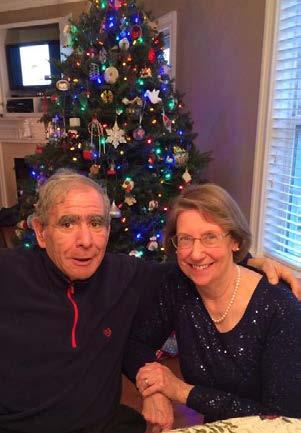
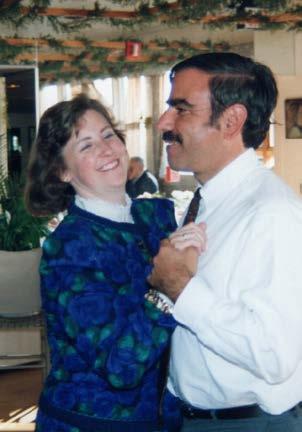

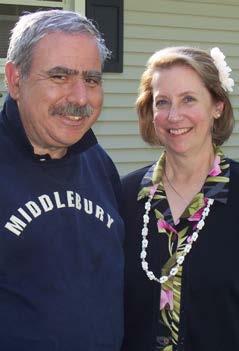
Did You Know?
• Parkinson’s disease is a progressive neurological disorder affecting movement, speech, cognition and other aspects of daily life — there is no cure
• A study was released in 2022 showing the incidence, the number of new cases diagnosed per year, is 50% higher than previous estimates — the study determined there are approximately 90,000 new cases of Parkinson’s diagnosed in the U.S. per year
My family knew very little about Parkinson’s disease prior to 2006 when my Dad, Rocco “Roc” Erardi, was first diagnosed.
He had been fighting symptoms and misdiagnoses for several years before learning he had Parkinson’s. The diagnosis came just six months after my Mom, Mary Lou, retired from a 35-year teaching career at Avon High School. In one fell swoop, they knew their retirement would look very
different than they had envisioned. Nonetheless, they pushed forward together in ways that continue to inspire everyone around them.
Prior to Parkinson’s, my Dad was very active. He served honorably in the Army Reserves for eight years. He also successfully juggled his career with community engagement.
He was vice president and a longtime board member of the Avon Soccer Club, where he coached for 18 years before becoming an assistant coach for Connecticut’s Olympic Development Program. He was cofounder of the Avon Memorial Day Soccer Tournament, now in its 34th year. Noting his years of contributions, dedication and selflessness in providing a legacy that helped guide thousands of Avon youth, my Dad was named VP emeritus of the Avon Soccer Club.
Parkinson’s robbed my Dad of his passion of going to the Fisher Meadows Recreation Area to watch youth soccer. I would give anything to be back there with him. You do not realize just how inaccessible many things are until you need to navigate with a walker or wheelchair.
inspiration. He was a phenomenal Dad to me and my brother Scott.
Throughout the years, my Mom was a fantastic caregiver, and she became a fierce advocate for my Dad. She also saw a broader need, and took action. She joined the Canton Commission on Aging to lend a voice to Canton seniors — my parents had moved to Canton in 2009 for their retirement.
After having to park a great distance away from Canton Town Hall on a presidential election day, and seeing my Dad struggle to navigate the terrain and long lines with a walker, my Mom was instrumental in getting major election voting moved to local schools where parking is plentiful and access is far easier.
My parents fought Parkinson’s together with an unshakable resolve.
D
D
D
D
D
D
D
D

He was not deterred, however. He channeled his competitive spirit and tenacity into fighting Parkinson’s every day with strength, courage and grace. My Dad was, and will always be, a role model and an
My Dad passed away on July 24, 2022 after battling Parkinson’s for 16plus years with unwavering courage and determination. Through it all, he never complained. He would just occasionally say, “I wish they’d find a cure for this thing.”
So, as hard as it is to approach each day without him, we carry on in his memory. We advocate for Parkinson’s awareness and we try to approach each day with his same strength and perseverance.
My Dad’s legacy is one of community engagement, positive influence and kindness. He left an indelible mark on the lives of those around him. He is a beacon of light in the fight against Parkinson’s. We are very proud the American Parkinson



Disease Association (APDA) has selected my Dad as this year’s Northern CT Optimism Walk honoree. The APDA is the largest grassroots network dedicated to fighting Parkinson’s.
Our team, the ROCkin’ Rollers, will be walking in memory of my Dad’s enduring spirit and determination on May 4 at the Farmington Polo Club. The Northern CT Optimism Walk is a fun, family-friendly event that features a 1.5-mile paved walk, entertainment and more.
It is a day of strength, hope and unity — and my family and I proudly accept this honor on my Dad’s behalf.
My family has lived in the Farmington Valley for 54 years. My parents moved to Farmington when they got married in 1970, and then to Avon around 1980. They moved to Canton in 2009.
My brother Scott and I went through the Avon school system and are graduates of Avon High School — he graduated in 1991 and I graduated in 1996. I consider the Farmington Valley my home, though I currently live in Cromwell. Scott has lived in Avon for 27 years. +
A native of Avon, Lauren Erardi is the vice president of the Connecticut chapter of the American Parkinson Disease Association — she works at Travelers Insurance as a director of learning and development — previously she was the director of academic technology at Quinnipiac University CLICK HERE — for Rocco “Roc” Erardi’s obituary

IN CONJUNCTION with our coverage of Parkinson’s disease in this edition, Today Magazine has received insight from experts at key area hospitals and the state APDA chapter — here are their illuminating answers to an exclusive three-question Today Q&A.
The three questions are as follows:
1 — Various Parkinson’s organizations offer different definitions and descriptions of Parkinson’s disease, with common threads — what is your take on the best definition of Parkinson’s disease?
2 — Please evaluate the following statement regarding a Parkinson’s diagnosis — “The good news: Most people find acceptance and quality of life after the initial adjustment period” — to what extent do you agree with this statement?
3 — One prominent Parkinson’s-related website says a cure for Parkinson’s disease is within reach, while another says no cure is in sight — what is your take on the question of a cure?

Dr. Bernardo Rodrigues has answered this Q&A on behalf of UConn Health — he is the division chief for the Parkinson’s Disease and Movement Disorders Program — Farmingtonbased UConn Health has other locations in Connecticut, including a few more in the Valley
1 — Parkinson’s disease (PD) is the second most common neurodegenerative condition affecting Americans, second only to Alzheimer’s disease. A Parkinsonian syndrome (or Parkinsonism) refers to a group of conditions that presents with a combination of resting tremors, stiffness and slowed movements. Parkinson’s disease is the most common Parkinsonian syndrome, but there are others that must be differentiated: Dementia with Lewy Bodies, Multiple System Atrophy, Progressive Supranuclear Palsy and Corticobasal Degeneration.
2 — Parkinson’s disease is a progressive disease that can lead to disability and can affect activities of daily living, which makes it a shocking diagnosis. Since it is relatively rare, there is much that is unknown to the patient and their families, but with proper education they can understand the condition better and adjust quickly to the new challenges.
PD affects primarily the motor function — tremors, stiffness, slowed movements and balance changes — so most of the adjustments revolve around optimizing physical condition and safety. The current treatments available to treat PD offer remarkable improvement of symptoms and can allow patients to continue to be fully independent for years. We feel that with proper care, dedication to regular physical activity, exercising and fall prevention, patients can live a long, happy and healthy life.
3 — It is always difficult to try to predict the future — however, the speed of technological advancements has been picking up and we have strong reasons to be optimistic.
We have had several new scientific discoveries that open new leads for potential cures for Parkinson’s disease.
Many research groups have been investigating biomarkers for PD (alphasynuclein)*, new medications that have shown potential to slow down PD (GLP-1 agonists) in small trials** and the development of new mechanisms of disease — such as the importance of gut health/microbiome and other inflammatory markers as potential ways to cure PD.
I just want to highlight that with proper diagnosis and management patients with PD can live long, productive, happy lives. This is a very serious condition, but slowly progressive and with extremely effective symptomatic treatments, which includes medications and surgical interventions, such as deep brain stimulation (DBS) and MRIguided High Intensity Focused Ultrasound Thalamotomy (MRfUS). Following with a Movement Disorders Neurologist further improves outcomes.
* Michael J. Fox Foundation research on alpha-synuclein — SYN-ONE test R (CND Life Sciences) skin biopsy test for alpha-synuclein — available at UConn
** Trial of lixisenatide in early Parkinson’s disease — New England Journal of Medicine 2024 — 390:1176-1185
Dr. Nirav Sanghani has answered this Q&A on behalf of Saint Francis Hospital and Trinity Health of New England — he is a staff physician in the Department of Neurology — Saint Francis Hospital is part of the Trinity Health system with locations across Connecticut, including a few in the Farmington Valley
1 — Most neurophysicians use the United Kingdom Parkinson Disease Society (UKPDS) brain bank criteria for diagnosis of Parkinson’s disease, the first step of which includes slowness of movements as a required feature and at least one of the other findings,
muscle stiffness/rigidity, tremors and difficulty/abnormality while walking. The further definition requires excluding other disorders which can mimic Parkinson’s disease.
2 — The acceptance of a newly diagnosed Parkinson’s disease and its effect on quality of life depend upon the severity of symptoms. In general, many people find no significant change in quality of life, especially with the recent advances in physical therapy combined with medications.
3 — Parkinson’s disease occurs because certain areas of the brain do not produce a chemical called dopamine. Most of the current treatments are directed toward supplementing dopamine, or enhancing the effect of whatever dopamine is present in the brain.
Theoretically, the disease can be cured if we can find a way to insert stem cells in the brain which can produce the required dopamine. There have been ongoing trials for stem cell therapy in Parkinson’s disease — however, it will take some time for this to become the standard for treatment.
Dr. Joy Antonelle de Marcaida has answered this Q&A on behalf of Hartford HealthCare — she is the medical director for the David & Rhoda Chase Family Movement Disorders Center — Hartford Hospital is based in Connecticut’s capital city and Hartford HealthCare has locations throughout Greater Hartford, including a few in the Farmington Valley
1 — Parkinson’s disease is a chronic progressive neurodegenerative disorder primarily affecting a part of the brain called the substantia nigra. This part of the brain produces a neurochemical called dopamine, which is predominantly involved in controlling movement. As such, loss of brain cells in the substantia nigra results in a dopamine deficiency and manifests with these cardinal motor symptoms: slowness of movement, rest tremor, rigidity of the muscles and balance impairment.
2 — I don’t like the phrasing of that statement and don’t agree with its premises. I don’t think this is what I
would choose as the “good news” after a diagnosis of PD, and I don’t think people “find acceptance and quality of life after the initial adjustment period.”
If you were to ask me what the “good news” is after making a diagnosis of PD, what I personally share with my patients is that, for the most part, Parkinson’s disease is slowly progressive and current research shows there are many things we can do for ourselves that can change the trajectory of its progression. This means that, in many ways, the power over Parkinson’s disease is in your hands.
Overall wellness is key: exercise, eating healthy, sleeping well, keeping mentally engaged, maintaining social connections and avoiding stress can slow down the progression of the disease.
Furthermore, there are currently over 30 medications and procedural options that quite effectively treat the symptoms of PD, and research in the field is robust. Partnering with specialists who can guide PD patients toward the best interventions to optimally manage their symptoms then



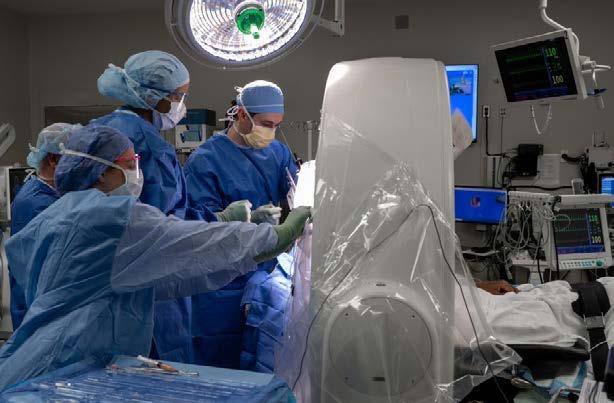
allows them to maintain their quality of life and live their lives to the fullest despite this diagnosis.
3 — The pathology of Parkinson’s disease is complex, and we now know that this can predate the diagnosis of PD by decades. As such, finding a cure has proven to be quite challenging. However, each year of research brings us a deeper understanding of its pathophysiology, and closer and closer to finding a cure.
There is a lot of optimism in the field right now that targeted therapies show great promise as potential disease-modifying agents, but for research on these compounds to move forward, we need to encourage participation in clinical trials. If we can encourage more people with Parkinson’s disease to volunteer to participate in clinical trials, then the world can keep moving closer toward finding the cure.
Each person who volunteers for a research study contributes to the body of knowledge and to the development
of new therapeutic options that will eventually benefit the whole world of people with Parkinson’s disease. If thought of in this way, isn’t this such a soulfully satisfying accomplishment worth aspiring for? Someday, the participants in the study of the compound that proves to be the cure will be able to say: “Because of me, the whole world can now say WE have ended Parkinson’s disease.”
Bill Patjane has answered this Q&A on behalf of the Connecticut chapter of the American Parkinson Disease Association – he is APDA’s regional director for the northeastern states — the APDA national office is based in Staten Island NY
1 — From the APDA website: Parkinson’s disease (PD) is a type of neurologic movement disorder, affecting the brain and causing difficulty with movements, or motor symptoms. It is characterized by its
most common motor symptoms — tremors (a form of rhythmic shaking), stiffness or rigidity of the muscles, and slowness of movement (called bradykinesia) — but also manifests in non-motor symptoms including sleep problems, constipation, anxiety, depression and fatigue, among others, which can be present well before any visible motor symptoms. It is a chronic and progressive condition, meaning that the symptoms become worse over time and can affect the ability to perform common, daily activities.
2 — Everybody’s path to diagnosis and progression is different. This requires individual attention, something that APDA is able to provide in our community with various programs and services for individuals, families and care partners. Parkinson’s disease affects individuals, family and friends.
3 — Recently there have been advancements in testing for PD, treating the symptoms, and finding a cure. +

Lauren Magel is an Avon resident — in this article she shares her family’s experience with Parkinson’s disease in honor of her dad Jeff Horton, who died in March, and her mom Dee Horton
PARKINSON’S is a debilitating disease for both the patient and the family. This is a little bit about our journey. Maybe like most diseases, it becomes a way of life.
My dad was unstoppable! He was always moving things, fixing things, working in the yard, running around town to drop off favorite things to his friends and family, and at age 60 decided to give up smoking and run a marathon with my sisters and me!
His life was centered around doing things with and for his family — nothing else mattered. As I said when I spoke at his funeral, there was no such thing as the grass being greener on the other side because he was so happy right where he was.
With my dad, it wasn’t something
we dwelled on — he didn’t want to let this decide the way he lived his life
I think this is what got him through the years of living with Parkinson’s. I remember when I first noticed a slight tremor in his hand. I remember him saying it was fine. I think he knew before he was diagnosed that something was going on.
Once he retired, he went to all of the doctors you could think of wanting to make sure he was in good health. He was always so proud of how clear his lungs were after smoking for many years. He would tell us that it is never too late for good health. This is when it was confirmed that he had Parkinson’s. He started on some meds and never once let it stop him.
Years went by with life as usual. My mom and dad were there for everything! They traveled for soccer games, dance recitals, lacrosse games, musicals, first and last days of school — you name it, they wanted to be there and they were!
I think it’s because I was living in Connecticut and would come back that I did notice the slight changes every time we visited — my parents were in Sayville NY, where I grew up on Long Island. Each time he was a little bit slower, would fall a little more, and eventually life would get a little harder.
But with my dad, it wasn’t something we dwelled on. He didn’t want to let this decide the way he lived his life. Sometimes it was frustrating because he would refuse to
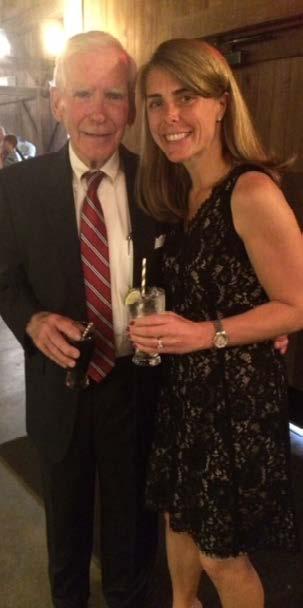
use his cane — he claimed he would forget it! Or he would not understand why driving wasn’t an option, but he would quickly busy himself with something else.
He was always tinkering in the garage, fixing things and bringing things back to life that most people would have thrown away. When he would fall, he would pop up faster than you could say are you OK — like I said, unstoppable!
Winters were always the hardest because there was less that he could go and do. One of the side effects was that his body was always cold, so being outside in the winter became
harder. Instead, he was always up on the latest News 12 Long Island news and he always had a Newsday article that he cut out for you to read. He always wanted to be busy and he always wanted to be doing things for others.
One week in January, the falls seemed to be a bit more intense. He wasn’t able to catch himself the same way and getting up was harder than usual.
At a regular doctor’s appointment it was discovered that his hemoglobin levels were shockingly low. He was rushed to the hospital immediately.
The hospital was never a good place for my dad. It seemed whenever he went there, other things happened. I am referring to two other times he was there after falling and breaking his hip.
His mind would play tricks on him. He was unsure of night and day. The medication intended to calm him down
didn’t help. And since he was confused about day and night, physical therapy was tricky. Often he would miss chances to get his body up and moving.
Days turned into weeks. His days were filled with visits from family and winning over the hearts of his nurses. We found ourselves sneaking him Diet Coke and jelly donuts! He wasn’t able to say or do much in those last days, but I know he could hear us.
His last days were long. His room started to feel too small and too familiar. On one of his last days, the sun was finally shining and we were able to take him outside. Fresh air and sunshine were exactly what we all needed.
I won’t get into this last part of his story, because this wasn’t him.
This wasn’t the man whose face would light up when you walked in the room. This wasn’t the dad who ran
groceries to me at college just because he wanted to say hi. This wasn’t the grandpa who got such joy out of having all of his grandchildren swimming in the pool in the backyard and giving them ice cream, no matter what time of day it was. But I will say, he took his final breaths peacefully, surrounded by those who loved him, and that’s exactly how he wanted it.
So I will leave you with this: “I could not, at any age, be content to take my place by the fireside and simply look on. Life was meant to be lived. Curiosity must be kept alive. One must never, for whatever reason, turn his back on life.”
— Eleanor Roosevelt +
Lauren Magel is a Green Compass advocate serving as a hemp wellness educator — she was a longtime teacher in the Farmington school system • 631-877-0441 laurenmagel519@gmail.com



Canton resident Sharie Weakley produced this painting in 2023 utilizing a photo of a snowscape at the Hill-Stead Museum in Farmington — “I did not paint it on-site, but rather from the photo,” she explains — This artwork is on display at Valley Chiropractic & Sports Medicine in Simsbury
Contact the artist via email weakleyfamily@comcast.net













860-965-3652


860-674-0300
860-693-2876 Office
860-593-9826 Cell 860-676-1400 Fax juilusandgail@cbmoves.com



• These advertising sponsors have seen the value of investing in Today Magazine’s award-winning journalism as we cover the heart of the Farmington Valley and aim to record the Valley’s underreported upside •
• If you have paid for a recurring advertisement with Today Magazine but don’t see your business or organization listed, send an email so you can be added to our Advertiser Hall of Fame — advertise@todaypublishing.net •
Anthology Senior Living — 860-546-8037 — Simsbury www.anthologyseniorliving.com > Location
Avon Health Center — 860-673-2521 — Avon www.avonhealthcenter.com
Avon Historical Society — 860-678-7621 — Avon www.avonhistoricalsociety.org
A Teen Edge — 860-593-2822 www.ateenedge.com
Board and Brush — 860-392-8567 — Simsbury www.boardandbrush.com/simsbury
Canton Barn LLC — 860-693-0601 — Canton www.cantonbarn.com
Canton Food Bank — 860-693-5811 — Canton www.townofcantonct.org
Carmon Funeral Homes — 860-673-8610 www.carmonfuneralhome.com
Carol Cole Real Estate — 860-212-0687 — Canton www.carolcolerealestate.com
Cherry Brook Health Care Center — 860-693-7777 — Canton www.cherrybrookhcc.com
Christensen Insurance — 860-651-8236 — Simsbury www.insuranceagentswhocare.com
Christopher Bryant Co. — 860-243-3500 — Bloomfield www.thechristopherbryantcompany.com
Collinsville Bank — 860-693-6935 — Canton www.collinsvillebank.com
Connecticut Dance Academy — 860-707-4198 — Canton www.ctdanceacademy.com
Connecticut Headshots — 860-263-9277 — Avon www.connecticutheadshots.com
Dynamic Auto Works — 860-693-6359 — Canton www.facebook.com/DynamicAutoCanton
Erica Maglieri: Realtor — 860-324-6842 bhhsneproperties.com/real-estate-agent/757/erica-maglieri ———————————————————————————————
Floors Reincarnated — 860-651-1900 — Simsbury Facebook > Floors Reincarnated
Fresh Start Pallet Products — 860-266-5726 — Hartford www.freshstartpalletproducts.org
Granby-Simsbury Chamber of Commerce — 860-651-7307 www.simsburycoc.org
Green Door Restaurant — 860-693-9762 — Canton www.41bridgestreet.com
Habitat for Humanity — 860-541-2208 — Hartford www.hfhncc.org
Harris Home Improvement — 860-817-7191 — Granby www.harrishomeimprovement.net
Hartford Symphony Orchestra — 860-246-8742 — Hartford www.hartfordsymphony.org
HealthMarkets Insurance — 860-307-1128 — Torrington www.healthmarkets.com — Mel Brickman
Hulme & Sweeney Pianos — 860-408-4895 — Simsbury www.hulmesweeneypianoservice.com
Karedigs.com — 860-379-4340 — Barkhamsted www.karedigs.com
Kerian Home Health Care — 860-851-6267 — Simsbury www.keriancares.com
Kevin Witkos: State Senator
Landscape Solutions — 860-329-2014 — New Hartford www.landscapesolutionsct.com
Leslee Hill for State Representative
Lifetime Family Dentistry — 860-605-2075 — Collinsville www.lifetimefamilydentistryct.com
Linda Kessler: Realtor — 860-836-6172 — Avon www.coldwellbankerhomes.com > Agents
Liza Sivek Marketing — 203-278-5492 www.lizasivekmarketing.com
Maglieri Construction — 860-242-0298 — Bloomfield www.maglieri-construction.com
Magna Physical Therapy — 860-679-0430 — Avon www.magnapt.com
Maher’s Paint & Wallpaper — 860-678-1200 — Avon + Simsbury www.maherspaintandwallpaper.com
Make It GF — 860-693-1300 — Canton www.makeitgf.com
Mandel Vilar Press — 806-790-4731 — Simsbury www.mvpublishers.org
Massage Envy — 860-693-8000 — Canton www.massageenvy.com > Locations
The Master’s School — 860-651-9361 — West Simsbury www.masterschool.org
McLean — 860-658-3786 — Simsbury www.mcleancare.org
Nails of Envy — formerly Canton + Avon
Northwest Community Bank — 860-379-7561 www.nwcommunitybank.com
Odalys Bekanich: Realtor — 860-965-3652 — Avon www.coldwellbankerhomes.com > Agents
Peggy’s Personalized Promos — 860-379-7775 — New Hartford www.peggys.biz
Planning Partners LLC — 860-693-9916 — Canton www.planningpartner.com
Raimie Weber Jewelry — 860-409-3400 — Avon www.rweberjewelry.com
Randy Brolo: Book Author www.lulu.com > Spirit of Delilah
Ravenswood Natural Health — 860-264-1587 — Simsbury www.ravenswoodnaturalhealth.com
Red Bison General Contractor — 860-810-8581 — Hartford www.nextdoor.com/pages/red-bison-general-contractor-llc-hartfordct
Richman Business Brokerage — 860-408-9177 — Simsbury www.richmanbusiness.com — formerly The Deal Team
Stone Man Masonry — 860-693-4637 — Canton www.facebook.com/StoneManMasonryCT
Suburban Sanitation Service — 860-673-3078 — Canton www.subsanserv.com
Tom Kutz Photography — 860-693-6254 — Canton www.tomkutzphoto.com
Trading Post — 860-693-4679 — Canton www.tradingpostmusic.com
Transition Fitness Center — 860-398-1449 — Canton www.transition-fitness-center.business.site
UConn Health — 860-658-8750 www.health.uconn.edu
Up Top Barbershop — 860-658-4499 — Simsbury www.booksy.com > Up Top Barbershop
Vincent Funeral Homes — 860-693-0251 www.vincentfuneralhome.com
Vincent Tully: Realtor — 860-214-3030 www.coldwellbankerhomes.com > Agent
Welden Hardware — 860-658-4078 — Simsbury www.weldenhardware.com
William Raveis — 860-693-2987 — Avon www.raveis.com/agentfind.asp?smart=1
The Village for Families & Children — 860-236-4511 — Hartford www.thevillage.org/second-chance-shops
virtualens Designs — 860-348-6902 — Simsbury www.virtualens.art